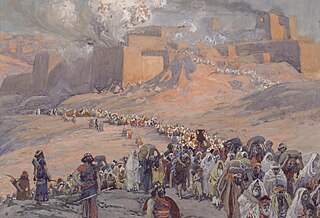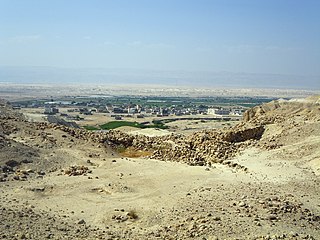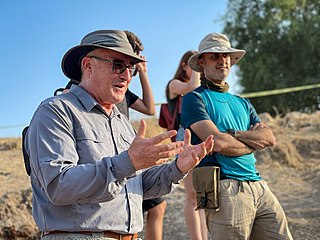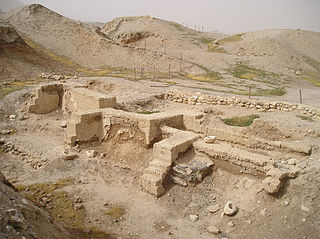
The Levant is an approximate historical geographical term referring to a large area in the Eastern Mediterranean region of Western Asia. In its narrowest sense, which is in use today in archaeology and other cultural contexts, it is equivalent to a stretch of land bordering the Mediterranean in southwestern Asia, i.e. the historical region of Syria, which includes present-day Syria, Lebanon, Jordan, Israel, Palestine and most of Turkey southwest of the middle Euphrates. Its overwhelming characteristic is that it represents the land bridge between Africa and Eurasia. In its widest historical sense, the Levant included all of the Eastern Mediterranean with its islands; that is, it included all of the countries along the Eastern Mediterranean shores, extending from Greece to Cyrenaica in eastern Libya.

The Israelites were a confederation of Semitic-speaking tribes in the ancient Near East who, during the Iron Age, inhabited a part of Canaan.

The Babylonian captivity or Babylonian exile is the period in Jewish history during which a large number of Judeans from the ancient Kingdom of Judah were captives in Babylon, the capital city of the Neo-Babylonian Empire, following their defeat in the Jewish–Babylonian War and the destruction of Solomon's Temple in Jerusalem. The event is described in the Hebrew Bible, and its historicity is supported by archaeological and non-biblical evidence.

The Dead Sea Scrolls are ancient Jewish and Hebrew religious manuscripts discovered in 1946/47 at the Qumran Caves in what was then Mandatory Palestine, near Ein Feshkha in the West Bank, on the northern shore of the Dead Sea. Dating from the 3rd century BCE to the 1st century CE, the Dead Sea Scrolls are considered to be a keystone in the history of archaeology with great historical, religious, and linguistic significance because they include the oldest surviving manuscripts of entire books later included in the biblical canons, along with deuterocanonical and extra-biblical manuscripts which preserve evidence of the diversity of religious thought in late Second Temple Judaism. At the same time they cast new light on the emergence of Christianity and of Rabbinic Judaism. Most of the scrolls are held by the State of Israel in the Shrine of the Book at the Israel Museum, but some of them had been taken to Jordan and are now displayed at The Jordan Museum in Amman. Ownership of the scrolls, however, is claimed by the State of Palestine.

The Southern Levant is a geographical region encompassing the southern half of the Levant. It corresponds approximately to modern-day Israel, Palestine, and Jordan; some definitions also include southern Lebanon, southern Syria and/or the Sinai Peninsula. As a strictly geographical description, it is sometimes used by archaeologists and historians to avoid the religious and political connotations of other names for the area.

The Arabah, Araba or Aravah is a loosely defined geographic area south of the Dead Sea basin, which forms part of the border between Israel to the west and Jordan to the east.

Israel Finkelstein is an Israeli archaeologist, professor emeritus at Tel Aviv University and the head of the School of Archaeology and Maritime Cultures at the University of Haifa. Finkelstein is active in the archaeology of the Levant and is an applicant of archaeological data in reconstructing biblical history. He is also known for applying the exact and life sciences in archaeological and historical reconstruction. Finkelstein is the current excavator of Megiddo, a key site for the study of the Bronze and Iron Ages in the Levant.

The United Monarchy is the name given to the united Israelite kingdom of Israel and Judah during the reigns of Saul, David, and Solomon, as depicted in the Hebrew Bible. It is traditionally dated to have lasted between 1047 BCE and 930 BCE. On the succession of Solomon's son Rehoboam in c. 930 BCE, the Biblical account reports that the country split into two kingdoms: the Kingdom of Israel in the north and the Kingdom of Judah in the south.
Richard Elliott Friedman is a biblical scholar and the Ann and Jay Davis Professor of Jewish Studies at the University of Georgia.

Bab edh-Dhra is the site of an Early Bronze Age city located near the Dead Sea, on the south bank of Wadi Kerak with dates in the EB IB, EB II, EB II-III and EB IVA. Bab edh-Dhra was discovered in 1924 on an expedition led by William F. Albright. Artifacts from Bab edh-Dhra are on display at Museum at the Lowest Place on Earth, Jordan; Karak Archaeological Museum in Jordan; the Kelso Bible Lands Museum housed at Pittsburgh Theological Seminary in Pittsburgh, PA, USA; The Gustav Jeeninga Museum of Bible and Near Eastern Studies in Anderson, IN, USA; and the British Museum in London.

Aren Maeir is an American-born Israeli archaeologist and professor at Bar Ilan University. He is director of the Tell es-Safi/Gath Archaeological Project.
The prehistory of the Levant includes the various cultural changes that occurred, as revealed by archaeological evidence, prior to recorded traditions in the area of the Levant. Archaeological evidence suggests that Homo sapiens and other hominid species originated in Africa and that one of the routes taken to colonize Eurasia was through the Sinai Peninsula desert and the Levant, which means that this is one of the most important and most occupied locations in the history of the Earth. Not only have many cultures and traditions of humans lived here, but also many species of the genus Homo. In addition, this region is one of the centers for the development of agriculture.

Levantine archaeology is the archaeological study of the Levant. It is also known as Syro-Palestinian archaeology or Palestinian archaeology. Besides its importance to the discipline of Biblical archaeology, the Levant is highly important when forming an understanding of the history of the earliest peoples of the Stone Age.

Philistine Bichrome ware is an archaeological term coined by William F. Albright in 1924 which describes pottery production in a general region associated with the Philistine settlements during the Iron Age I period in ancient Canaan. The connection of the pottery type to the "Philistines" is still held by many scholars, although some question its methodological validity.

The California Institute for Telecommunications and Information Technology (Calit2, previously Cal(IT)2), also referred to as the Qualcomm Institute (QI) at its San Diego branch, is a $400 million academic research institution jointly run by the University of California San Diego (UCSD) and the University of California, Irvine (UCI); in January 2022, plans were announced to add University of California, Riverside to the consortium. Calit2 was established in 2000 as one of the four UC Gray Davis Institutes for Science and Innovation. As a multidisciplinary research institution, it is conducting research discovering new ways in which emerging technologies can improve the state's economy and citizens' quality of life. Keeping in mind its goal of addressing large-scale societal issues, Calit2 extends beyond education and research by also focusing on the development and deployment of prototype infrastructure for testing new solutions in real world environments. Calit2 also provides an academic research environment in which students can work alongside industry professionals to take part in conducting research and prototyping and testing new technologies.

Nonferrous archaeometallurgy in the southern Levant is the archaeological study of non-iron-related metal technology in the region of the Southern Levant during the Chalcolithic period and Bronze Age from approximately 4500BC to 1000BC.

Wadi Feynan or Wadi Faynan is a major wadi and region in southern Jordan, on the border between Tafilah Governorate and Aqaba and Ma'an Governorates. It originates in the southern Jordanian Highlands with the confluence of Wadi Dana and Wadi Ghuweyr, and drains into the Dead Sea via Wadi Araba.
Khirbat Faynan, known in late Roman and Byzantine texts as Phaino or Phaeno, is an archaeological site in Wadi Faynan, southern Jordan. It lies just south of the Dead Sea in Jordan. The site was an ancient copper mine that overlooks two Wadis and is the location of one of the best and most well preserved ancient mining and metallurgy districts in the world.

Steven A Rosen is the Canada Chair in Near Eastern Archaeology in the Archaeological Division of the Department of Bible, Archaeology and Ancient Near East at Ben-Gurion University of the Negev. He serves as the Vice President for External Affairs. His research has focused on two general areas, the continued use of chipped stone tools in the periods during which metals were already exploited, and the archaeology of mobile pastoralists, using the Negev as an in-depth case study.
William H. C. Propp is an American historian of Near-East civilizations. Propp served as a professor of history at the University of California San Diego (UCSD) from 1983 until his retirement in 2017. Propp studied Near eastern languages and civilizations at Harvard University before teaching at UC San Diego in 1983 at the Judaic Studies Department.















